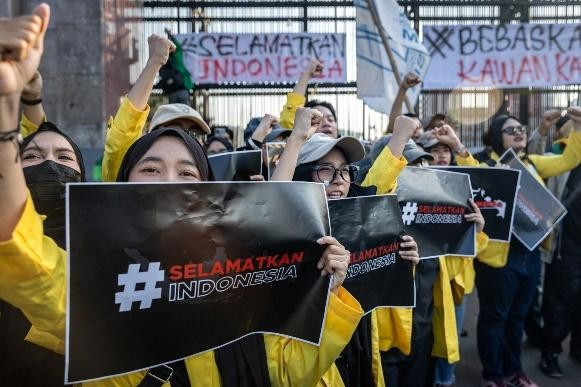Popular Reads
Top Results
Can't find what you're looking for?
View all search resultsPopular Reads
Top Results
Can't find what you're looking for?
View all search resultsPositive climate developments to watch unfold in 2021
In the spirit of New Year positivity though, and as we reflect on (the strange year that was) 2020 and look ahead to 2021, here are five reasons that fill me with hope when it comes to climate action.
Change text size
Gift Premium Articles
to Anyone
 Environmentalists march in the Asia Climate Rally toward the Energy and Mineral Resources Ministry in Central Jakarta on Nov. 27. They demanded that the government and businesses stop funding the expansion of fossil fuel exploitation to help limit climate change. JP/Dhoni Setiawan (JP/Dhoni Setiawan)
Environmentalists march in the Asia Climate Rally toward the Energy and Mineral Resources Ministry in Central Jakarta on Nov. 27. They demanded that the government and businesses stop funding the expansion of fossil fuel exploitation to help limit climate change. JP/Dhoni Setiawan (JP/Dhoni Setiawan)
W
hile many in 2020 heralded the short-term positive effects of COVID-19 on the environment, a pandemic alone will not reverse climate change. We are far off track to meet the targets set by the landmark Paris Agreement, with which world leaders agreed to limit global warming to 2 — or preferably 1.5 — degrees Celsius, compared to preindustrial levels.
In the spirit of New Year positivity though, and as we reflect on (the strange year that was) 2020 and look ahead to 2021, here are five reasons that fill me with hope when it comes to climate action.
First, governments across Asia commit to carbon neutrality.
China, Japan and South Korea together accounted for one-third of all global carbon emissions in 2018, according to Greenpeace, so the unprecedented pledges by the three East Asian nations in 2020 to achieve carbon neutrality by 2050 (South Korea and Japan) and 2060 (China) signal a significant win for the planet.
These bold commitments by some of the world’s worst polluters will hopefully lead to a snowball effect and catalyze climate action across the region.
New Zealand has taken one step further by enacting the 2050 target into law, following in the footsteps of the United Kingdom and the European Union. The country also declared a climate emergency at the end of 2020 and has committed to a carbon neutral public sector by 2025.
Activists are welcoming these ambitious declarations but are challenging governments (and companies) to walk the talk with measurable, long-term plans and tangible policy changes, including a transition to 100 percent renewable energy and the scrapping of fossil fuel investments.
Second, rapid tech sees rapid advances and declining costs in the renewables sector.
According to the International Energy Agency (IEA)’s latest World Energy Outlook, renewable energy remains resilient even amid the pandemic, and if electricity demand recovers and surpasses pre-COVID levels in 2021, renewables are projected to provide nearly 40 percent of global electricity supply by 2030.
Thanks to rapid cost reductions over the past decade, setting up solar photovoltaic systems is cheaper than new coal- or gas-fired power plants in most countries, and solar is poised to offer the most economical source of electricity.
In October 2020, the world’s largest solar and wind power generator, United States energy company NextEra surpassed oil and gas giant ExxonMobil – once the world’s most valuable company – in market value – a powerful indicator of renewables’ eclipse of oil.
One of the key challenges faced by the renewables sector is the responsible end-of-life management of solar panels, wind turbines and batteries, but the industry has made massive strides in embracing circularity in its manufacturing processes.
According to Assad W. Razzouk, CEO of clean energy company Sindicatum, the recycling efficiency of solar panels has reached a staggering 96 percent, 85 to 90 percent of all wind turbines are recyclable and 95 percent of lithium-ion battery components can be repurposed into new batteries or for use in other industries.
Third, sustainable investments show resilience amid COVID-19, but banks still have a long way to go to exit fossil fuels.
Data from various sources, including Morgan Stanley and S&P Global, show that environmental, social and governance (ESG) funds have reportedly outperformed the broader market during the COVID-19 economic crisis.
While the resilience of these funds will continue to be stress-tested as we enter 2021, these figures dispel the myth that incorporating ESG criteria in portfolio choices might harm returns, and demonstrate that ESG funds might in fact help investors manage downside risk and volatility better than their traditional peers.
That said, the Bankrolling Extinction report revealed that in 2019, the world’s 50 largest banks collectively invested more than US$2.6 trillion in the food, forestry, mining, fossil fuels, infrastructure, tourism, transport and logistics sectors, considered as the key drivers behind the biodiversity crisis.
Pressure is mounting on financial institutions to implement a decarbonization strategy, although banks continue to inject a huge amount of funding into “dirty industries” such as fossil fuels.
According to the Institute for Energy Economics and Financial Analysis (IEEFA), more than 150 global financial institutions have already put coal exit policies in motion. In addition, all major North American banks have ruled out financing for Arctic drilling in response to the controversial plans of US President Donald Trump's administration to auction drilling rights in the Arctic National Wildlife Refuge, which would undoubtedly endanger vulnerable wildlife and indigenous communities.
Fourth, the US commits to rejoining the Paris Agreement.
Joe Biden’s electoral win marked a decisive shift in US climate policy, as the president-elect has immediately announced that the US would rejoin the Paris Agreement and become carbon neutral by 2050.
On the domestic front, climate activists call on the new government to restore the more than 125 environmental regulations rolled back by the Trump administration, including rules to curb methane and carbon emissions from coal and gas-fired plants, or fuel-efficiency standards for passenger cars and heavy-duty trucks.
The appointment of former secretary of state John Kerry, one of the key architects behind the Paris accord, as special envoy for climate also sends a powerful message on the world’s largest economy adopting a more proactive role in international climate leadership.
It could help place more pressure on the global financial system to take concrete steps toward a net-zero future, including global standards for climate reporting or the mandatory disclosure of climate risks. As an indication that the tides are turning, the US Federal Reserve joined in December 2020 the Network of Central Banks and Supervisors for Greening the Financial System, which seeks to develop climate risk management solutions for the financial sector.
Fifth, countries adopt green recovery plans post-COVID-19.
It’s been widely discussed that the pandemic offers the world an opportunity to “build back better”, but government approaches to sustainability vary when it comes to recovery efforts.
A study by Vivid Economics and the Finance for Biodiversity Initiative has shown that among the economic stimulus packages of the world’s 17 major economies, 30 percent — $3.5 trillion — will be channeled into sectors that will impact the environment (either negatively or positively).
In 14 out of the 17 countries analyzed, including the US, China, Japan, India, South Africa, Russia, Indonesia and Brazil, stimulus spending that could harm the planet outweigh sustainable recovery efforts. In emerging economies with weak regulatory frameworks and that depend on carbon-intensive industries, including fossil fuels or unsustainable agricultural practices, a green recovery plan is especially challenging to implement.
On a more positive note, in addition to South Korea, Canada and some parts of Western Europe, the “Next Generation EU” recovery plan comes across as the most sustainable stimulus package to date. Recovery loans and grants to member states are conditioned on “do not harm” environmental safeguards, and incentives are put in place to reduce dependency on fossil fuels and improve energy efficiency, among other steps.
Other examples of green recovery investments target sustainable buildings and transport, digital and circular economy innovations, sustainable finance, good governance and nature-based solutions, such as sustainable forest management.
Governments and companies worldwide have made ambitious commitments to creating a net-zero future. But time is running out to meet the goals of the Paris climate deal, and 2021 will be a decisive year to see whether these lofty announcements translate into tangible action to address the climate emergency.
***
The writer is head of summits and sustainable events at Refinitiv.









